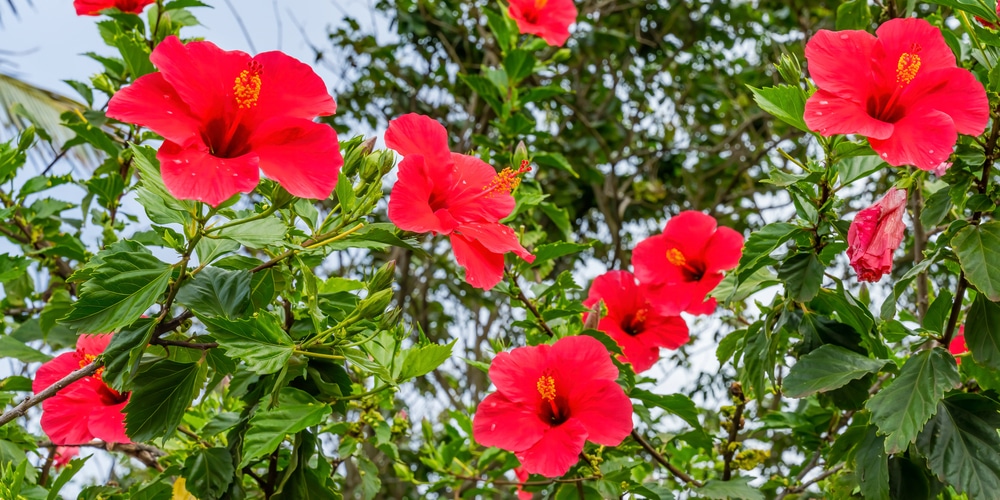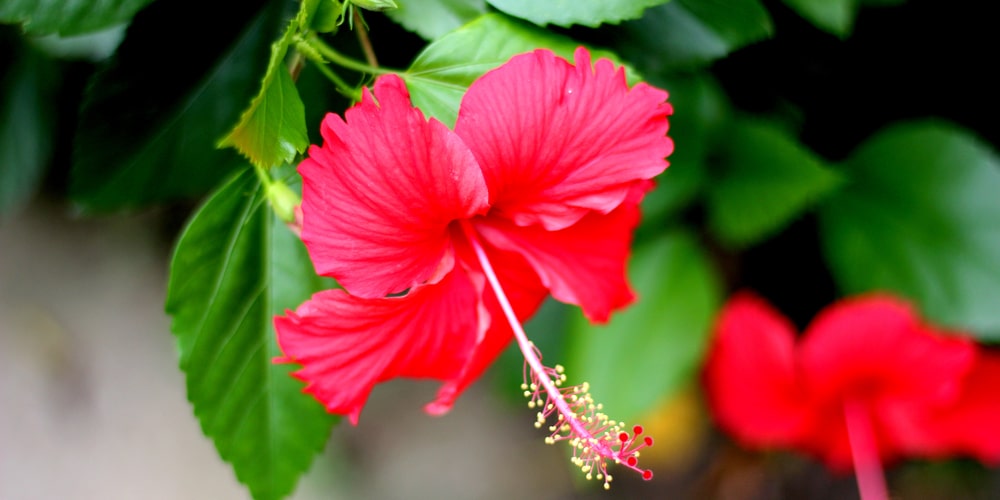Painted Lady Hibiscus plants are beautiful evergreen shrubs that are easy to care for and relatively fast-growing. This plant grows in various climates, from temperate to tropical, but is most commonly grown in USDA hardiness zones 10 to 12.
Painted lady hibiscus can be grown as a house plant in colder regions or can be grown in a container and moved indoors during the fall and winter. Be careful not to leave your plant outdoors if frost is likely. Let’s look at how to grow and care for a painted lady hibiscus correctly.
What is a painted lady hibiscus?
The Painted Lady Hibiscus is a plant that’s known for its beautiful flowers. The evergreen shrub is originally from Asia but can now be commonly found throughout the world. These plants have dark green leaves and are part of the Malvaceae family which has over 4000 plants. In the wild, painted lady hibiscus can grow up to ten feet tall with large flowers and leathery leaves. The painted lady hibiscus is a perennial.
The leaves can get fairly large, and the plants will produce flowers once it matures. The flower’s color ranges from light to darker pink, and the center is maroon-colored. The scientific name for a painted lady is Hibiscus rosa-Sinensis.
How to Care for a Painted Lady Hibiscus Plant
Indoor hibiscus plant care is pretty easy as these plants are relatively low maintenance. Since they are tropical plants, they prefer high temperatures and bright light. This makes them perfect for growing as houseplants. Be careful not to leave your plant in a draught from an open door or window or too close to air conditioning or heating vents, as these may affect the plant.
If you’re growing your painted lady hibiscus indoors, then soil needs to be kept moist but not wet. They prefer to have their soil evenly moist at all times without being soggy, as root rot may occur.
When growing hibiscus plants outdoors, it is essential to remember that they are tropical plants with tender leaves and stems. These plants can’t tolerate frost, harsh winds, or even temperatures below 50 degrees F.
The painted lady can be grown in USDA hardiness zones 10 to 12, where the soil does not freeze solid throughout the winter months. The top several inches of soil around your hibiscus should remain moist during the winter but not soggy. Hibiscus are heavy feeders, so any type of organic matter that has decomposed will do just fine for mulch to help retain moisture in the soil around its roots.
Sunlight
Give your plant plenty of bright light and sunshine, or place in partial shade. As with any plant that prefers bright light, too much direct sunlight can scorch or dry out its leaves, so put it in a location where it will receive bright indirect sun or partial shade.
Watering Requirements
When it comes to watering your hibiscus, you need to remember that this plant needs at least one inch of water every week. Check the soil regularly for signs of dryness. If the color of the leaves starts changing or if they start wilting, then your plant probably needs more water.
Soil
The Painted Lady Hibiscus is a plant that grows well in average, light, and well-draining soils. You need to keep the plant’s pH balance between 5.0 and 8.0 as it likes the earth to be neutral or slightly acidic.
You can use organic materials such as compost to help create the correct soil consistency. If your soil has an acidic level below 5.0, you need to add lime to make it more neutral.
If you want to grow hibiscus in containers, ensure you use a container with at least a ten-gallon capacity. The container must be able to drain out excess water effectively; otherwise, root rot may develop. If possible, avoid using plastic pots when planting a hibiscus because, over time, the roots will grow and may crack the pot. You can add a layer of gravel or stones to the bottom of the pot to help with drainage.
Temperature
The ideal temperature range for the hibiscus plant is between 70 degrees Fahrenheit to 85 degrees during the day. These plants can’t stand the cold, so the temperature must not fall lower than 55 degrees at night. Keep the temperature in mind before planting a painted lady hibiscus outdoors. It’s recommended that you only plant a painted lady hibiscus outside if you live in USDA zones 10 to 12.
If you live in a colder region, you can keep your plant indoors, but avoid placing it near cold drafts or vents because these may damage the plant’s foliage.
Fertilization
There are various ways to fertilize your painted lady hibiscus, the most effective for outdoor shrubs being using compost at least once every two months.
You can also use chemical or organic fertilizers, depending on your personal preferences. Wait at least two weeks after planting before applying chemical-based fertilizers. If you want to be sure that the plant will grow healthy and strong, make sure to provide it with enough sunlight and water regularly.
Humidity
The painted lady hibiscus plant prefers the humidity level to be at least 50% or higher. Ensure you monitor its area and see whether it needs more moisture. If you’re growing this plant indoors, you can place it on a tray with water and pebbles. As the water evaporates, it will provide moisture for your plant.
Conclusion
Painted lady hibiscus are beautiful flowering evergreen shrubs that do well in warm locations. They produce showy flowers that are a bright pink color throughout the spring and summer months. As these plants originate from tropical and subtropical climates, they like warm weather and plenty of sun. They should be watered regularly and provided with fertilizer and the correct humidity levels.
The painted lady hibiscus isn’t very cold tolerant and can easily be killed by frost. Only put your plant outdoors in a container or plant in a flower bed if you live in USDA zones 10 to 12.

